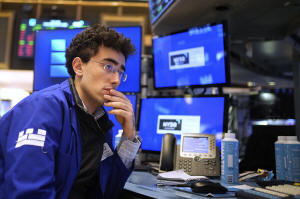Wall Street's euphoria sends US stocks to historic gains after Trump
pauses most of his tariffs
[April 10, 2025] By
STAN CHOE
NEW YORK (AP) — U.S. stocks soared to one of their best days in history
on a euphoric Wall Street Wednesday after President Donald Trump said he
would back off on most of his tariffs temporarily, as investors had so
desperately hoped he would.
The S&P 500 surged 9.5%, an amount that would count as a good year for
the market. It had been sinking earlier in the day on worries that
Trump’s trade war could drag the global economy into a recession. But
then came the posting on social media that investors worldwide had been
waiting and wishing for.
“I have authorized a 90 day PAUSE,” Trump said, after recognizing the
more than 75 countries that he said have been negotiating on trade and
had not retaliated against his latest increases in tariffs.
Treasury Secretary Scott Bessent later told reporters that Trump was
pausing his so-called ‘reciprocal’ tariffs on most of the country’s
biggest trading partners, but maintaining his 10% tariff on nearly all
global imports.
China was a huge exception, though, with Trump saying tariffs are going
up to 125% against its products. That raises the possibility of more
swings ahead that could stun financial markets. The trade war is not
over, and an escalating battle between the world’s two largest economies
can create plenty of damage. U.S. stocks are also still below where they
were just a week ago, when Trump announced worldwide tariffs on what he
called “Liberation Day.”

But on Wednesday, at least, the focus on Wall Street was on the
positive. The Dow Jones Industrial Average shot to a gain of 2,962
points, or 7.9%. The Nasdaq composite leaped 12.2%. The S&P 500 had its
third-best day since 1940.
The relief came after doubts had crept in about whether Trump cared
about the financial pain the U.S. stock market was taking because of his
tariffs. The S&P 500, the index that sits at the center of many 401(k)
accounts, came into the day nearly 19% below its record set less than
two months ago.
That surprised many professional investors, who had long thought that a
president who used to crow about records for the Dow under his watch
would pull back on policies if they sent markets reeling.
Wednesday’s rally pulled the S&P 500 index away from the edge of what’s
called a “bear market.” That’s what professionals call it when a
run-of-the-mill drop of 10% for U.S. stocks, which happens every year or
so, graduates into a more vicious fall of 20%. The index is now down
11.2% from its record.
Wall Street also got a boost from a relatively smooth auction of U.S.
Treasurys in the bond market Wednesday. Earlier jumps in Treasury yields
had rattled the market, indicating increasing levels of stress. Trump
himself said Wednesday that he had been watching the bond market
“getting a little queasy.”
Analysts say several reasons could be behind the rise in yields,
including hedge funds and other investors having to sell their Treasury
bonds to raise cash in order to make up for losses in the stock market.
Investors outside the United States may also be selling their U.S.
Treasurys because of the trade war. Such actions would push down prices
for Treasurys, which in turn would push up their yields.
Regardless of the reasons behind it, higher yields on Treasurys add
pressure on the stock market and push upward on rates for mortgages and
other loans for U.S. households and businesses.
The moves are particularly notable because U.S. Treasury yields have
historically dropped — not risen — during scary times for the market
because the bonds are usually seen as some of the safest possible
investments. This week’s sharp rise had brought the yield on the 10-year
Treasury back to where it was in late February.
[to top of second column] |

Alex Weitzman works on the floor at the New York Stock Exchange in
New York, Wednesday, April 9, 2025. (AP Photo/Seth Wenig)
 After approaching 4.50% in the
morning, the 10-year yield pulled back to 4.34% following Trump’s
pause and the Treasury’s auction. That’s still up from 4.26% late
Tuesday and from just 4.01% at the end of last week.
Of course, the trade war is not over. Bessent and Trump clearly
showed their anger at China, which has been ratcheting up its own
tariffs on U.S. goods and announcing other countermeasures with each
move Trump has made.
China earlier said it would raise tariffs on U.S. goods to 84% on
Thursday. “If the U.S. insists on further escalating its economic
and trade restrictions, China has the firm will and abundant means
to take necessary countermeasures and fight to the end” the Ministry
of Commerce said.
Later the U.S. Treasury secretary said in a message to countries
worldwide, but perhaps most directly aimed at China, “Do not
retaliate, and you will be rewarded.”
Wednesday's rally provided the latest reminder that some of the U.S.
stock market's best days have been clustered around some of its
worst days historically. That’s one of the reasons many financial
advisers suggest not trying to time the market and selling stocks
and other investments meant for the long term when nervous, because
of the risk of missing out on such huge up days.
The biggest gain for the S&P 500 since World War II was an 11.6%
surge on Oct. 13, 2008, for example. That was during the depths of
the Great Recession, when worries were high that the financial
system was collapsing and the S&P 500 was in the midst of a nearly
57% plunge from its peak in late 2007 until its bottom in March
2009. A couple weeks later, the index had another one of its best
days in history, soaring 10.8%.
Wednesday's gains were widespread across the U.S. stock market, and
98% of the stocks in the S&P 500 index rallied.
Leading the way were airlines and other stocks that need customers
feeling confident enough to travel for work or for vacation.

Delta Air Lines soared 23.4%. Earlier in the day, it had pulled
financial forecasts for 2025 as the trade war scrambles expectations
for business and household spending and depresses bookings across
the travel sector. All told, the S&P 500 rocketed higher by 474.13
points to 5,456.90. The Dow Jones Industrial gained 2,962.86 to
40,608.45, and the Nasdaq composite surged 1,857.06 to 17,124.97.
In stock markets abroad, indexes tumbled across most of Europe and
much of Asia after they closed before Trump’s announcement.
London’s FTSE 100 dropped 2.9%, Tokyo’s Nikkei 225 sank 3.9% and the
CAC 40 fell 3.3% in Paris. Chinese stocks were an outlier, and
indexes rose 0.7% in Hong Kong and 1.3% in Shanghai.
___
AP Business Writers Matt Ott and Elaine Kurtenbach contributed.
All contents © copyright 2025 Associated Press. All rights reserved |